The geocomposite capillary barrier drain (GCBD) is a method to suck water out of soil—that is, provide drainage while the soil is unsaturated. When placed between a base and subgrade, it can drain the unsaturated base and reduce its water content as well as prevent water from reaching the subgrade. In contrast to the GCBD, conventional drainage is designed for saturated flow, even though the positive pore water pressures required for saturated flow reduce strength and lead to pavement rutting, heaving, and failure. The GCBD comprises three layers that are, from top to bottom: a transport layer (a specially designed geotextile), a capillary barrier (a geonet), and a separator (geotextile). The principal function of the GCBD is illustrated in Figure 1. Water infiltrating through the base is prevented from moving into the underlying subgrade by the capillary barrier formed by the geonet. The transport layer (a special geotextile) becomes increasingly hydraulically conductive as it wets. If the GCBD is placed to dip from horizontal, water will drain along the slope in the transport layer. If the transport layer does not become saturated, no water will break through into the capillary barrier. The bottom separator protects the geonet from becoming filled with subgrade soil. The GCBD also cuts off capillary rise of water in the underlying soil, and if the overlying base and transport layer become saturated due to an extraordinary infiltration event, it provides saturated drainage in the geonet.

The final report is available from the National Technical Information Service (NTIS # PB2009-113226).
The final report for this IDEA project can be found at: